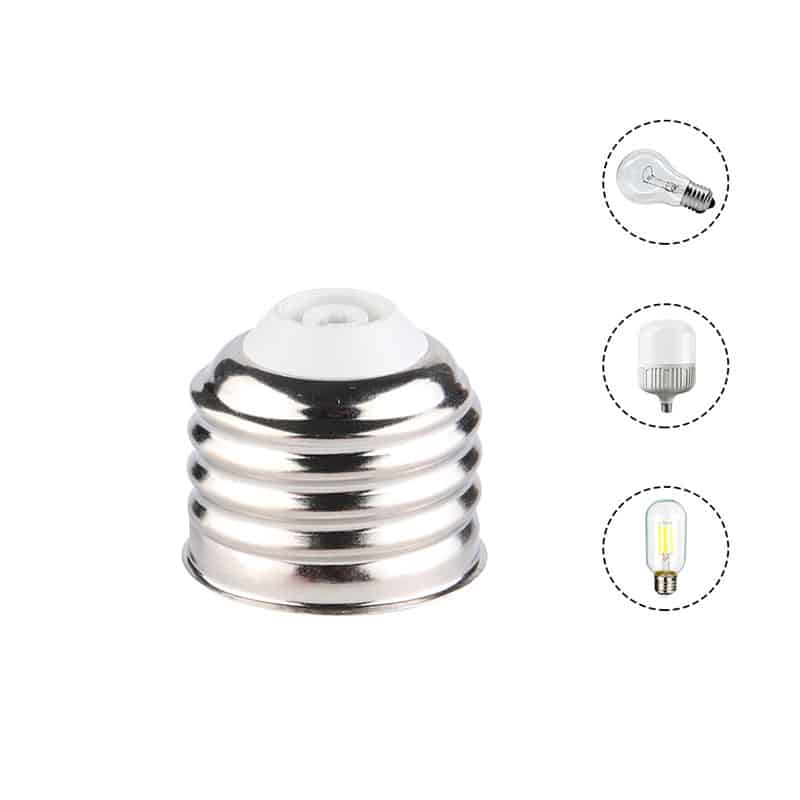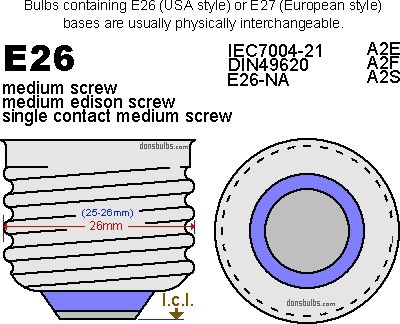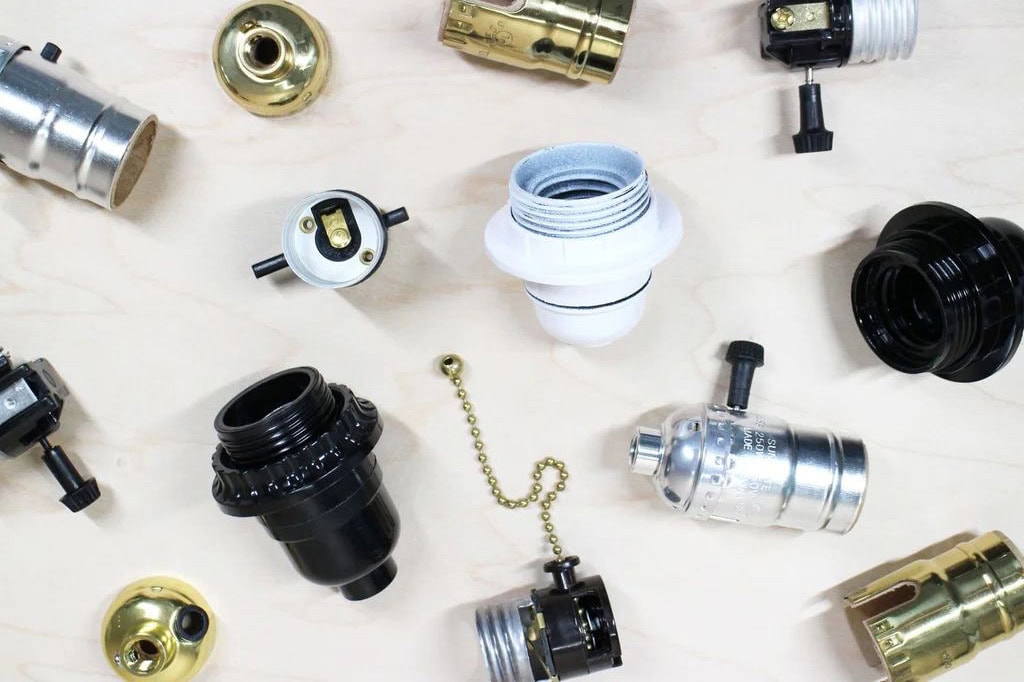Confused about whether an E26 bulb fits into an E27 socket? Using the wrong socket and bulb combination can cause electrical issues or poor lighting performance. Find out how to safely use E26 bulbs in E27 sockets.
Yes, you can typically use an E26 bulb in an E27 socket because they are nearly identical in size, with only a 1mm difference. However, you must verify voltage compatibility between the bulb and the socket.
Let’s look at the differences and similarities between the E26 and E27 to help you decide.

Understanding the E26 and E27 Bulb Bases
E26 and E27 bulb bases are both part of the Edison screw family, commonly used in various household and commercial lighting fixtures. The “E” stands for Edison, and the numbers 26 and 27 refer to the diameter of the base in millimeters.
- E26 Base: This is the standard medium screw base used in North America and Japan. It has a diameter of 26mm and is designed for 120V electrical systems.
- E27 Base: The E27 is the standard screw base used in most European countries and has a 27mm diameter. It is designed for use in 220V to 240V systems commonly found in Europe, Asia, and other regions.
Despite the 1mm size difference, both bases are mechanically similar and can often be used interchangeably in many fixtures. However, the voltage differences require careful consideration to ensure safety and proper operation.
Can an E26 Bulb Fit in an E27 Socket?
Yes, due to the minimal size difference of just 1mm, an E26 bulb can physically fit into an E27 socket. The threads on both bases are almost identical, allowing the bulb to screw in securely. This interchangeability makes it possible to use E26 bulbs in E27 sockets, provided that the voltage of the bulb matches the electrical system of the socket.
For example, if you are using a universal LED bulb rated for 100V-240V, you can safely use it in either an E26 or E27 socket. However, for bulbs with a fixed voltage rating, such as an E26 bulb rated for 120V, it may not be safe to use it in a 220V E27 socket without proper voltage regulation.

Safety Concerns When Using E26 Bulbs in E27 Sockets
One of the primary safety concerns when using an E26 bulb in an E27 socket is the difference in voltage between regions.
- Voltage Compatibility: E26 bulbs are typically rated for 120V systems, while E27 sockets are used in 220V-240V systems. If you attempt to use an E26 bulb that is not designed for higher voltage in an E27 socket, it could lead to overheating, bulb failure, or even electrical hazards.
- Universal LED Bulbs: If the bulb is a universal LED type with a wide voltage range, such as 100V-240V, it can be used safely in both E26 and E27 sockets. Always check the voltage rating on the bulb to ensure it is compatible with the socket and electrical system.
For the safest use, ensure that the voltage requirements match, especially when using high-voltage systems.
Are All E27 Bulbs Screw-In?
Yes, all E27 bulbs are designed with a screw-in base. This makes them easy to install in fixtures designed for E27 sockets, which are common in both residential and commercial lighting setups.
- Screw Design: The threaded design of E27 bulbs ensures a secure fit, providing stability and electrical contact in fixtures. This standardization makes it simple to replace bulbs without the need for adapters or specialized fixtures.
- Universal Compatibility: Because E27 is a widely used standard, screw-in bulbs can be used in a broad range of lighting fixtures across different regions.

How to Identify if Your Bulb Is E26 or E27
Identifying whether your bulb is E26 or E27 is simple:
- Markings: Both E26 and E27 bulbs are typically marked near the screw base with their designation (E26 or E27), making it easy to distinguish between the two.
- Regional Clues: The region where the bulb was purchased can also be a clue. In North America and Japan, bulbs are most likely to be E26. In Europe and other regions using 220V systems, bulbs are generally E27.
If there are no visible markings, you can also measure the diameter of the screw base. If it’s approximately 26mm, it’s an E26; if it’s closer to 27mm, it’s an E27.
Can You Use an LED Bulb in an E26 Socket?
Yes, LED bulbs are perfectly compatible with E26 sockets, as long as the bulb’s voltage matches the socket’s electrical system. LED bulbs designed for E26 sockets are typically rated for 120V systems, and they are widely available for residential and commercial use.
- Energy Efficiency: LED bulbs are highly energy-efficient and can significantly reduce electricity consumption compared to traditional incandescent bulbs.
- Long Lifespan: LED bulbs have a longer lifespan, meaning fewer replacements and lower maintenance costs. This makes them a great choice for fixtures with E26 sockets.
When choosing an LED bulb for an E26 socket, ensure that it is designed for the appropriate voltage to avoid any safety issues.

Using a B22 to E27 Adapter Safely
Adapters are available to convert B22 sockets to E27, allowing you to use an E27 bulb in a fixture originally designed for a B22 base.
- Adapter Safety: When using a B22 to E27 adapter, ensure that it is rated for the correct voltage and wattage. Adapters are generally safe to use, but improper voltage matching could lead to electrical hazards.
- Versatility: These adapters are particularly useful in older homes or fixtures that use B22 sockets, allowing you to use more widely available E27 bulbs without replacing the entire fixture.
Are E26 and A19 Interchangeable?
The term A19 refers to the shape and size of the bulb, not the base. A19 bulbs are typically equipped with an E26 base, making them compatible with E26 sockets.
- Standard Use: In most household fixtures in North America, an A19 bulb with an E26 base is commonly used for general lighting purposes.
- Compatibility: Since A19 bulbs typically come with an E26 base, they are interchangeable in any fixture that accepts E26 bulbs. Be sure to check the bulb’s base type before purchasing to ensure compatibility with your socket.
Is E26 Socket Standard?
Yes, the E26 socket is a standard in North America and Japan, and it is commonly found in a wide range of lighting fixtures. Whether for ceiling lights, lamps, or recessed fixtures, E26 sockets are the default choice for many household and commercial lighting solutions.
- Widespread Use: The E26 socket is the most commonly used socket for medium screw-base bulbs in the U.S. and Japan. It is compatible with a variety of bulb types, including incandescent, LED, and CFL bulbs.
- Universal Design: The standardization of the E26 socket makes it a versatile and reliable option for a wide range of applications, from decorative lighting to functional task lighting.

Final Words:
E26 bulbs can be used safely in E27 sockets as long as you verify voltage compatibility. Always check the voltage ratings on both the bulb and the socket to avoid any electrical issues or hazards.













